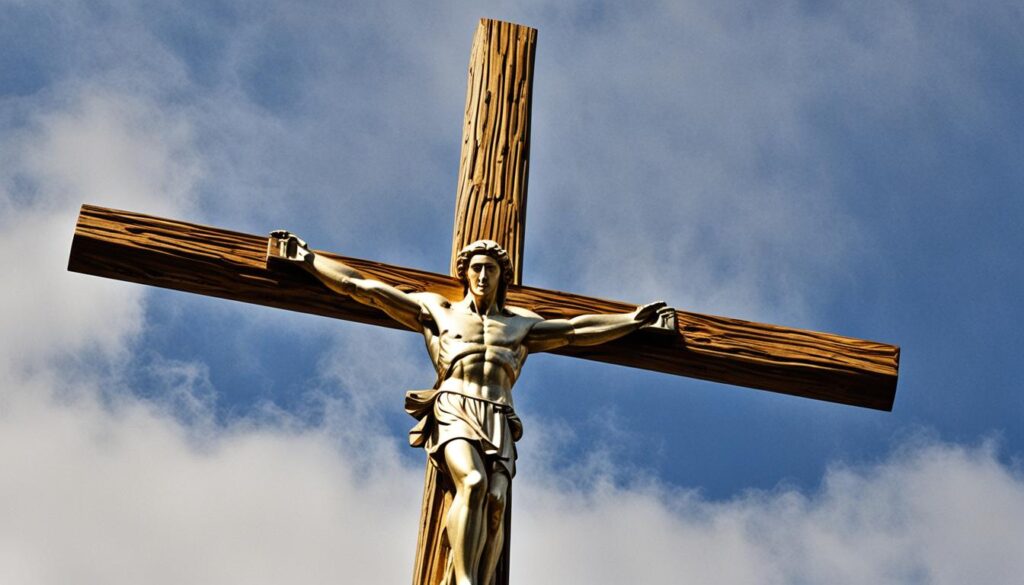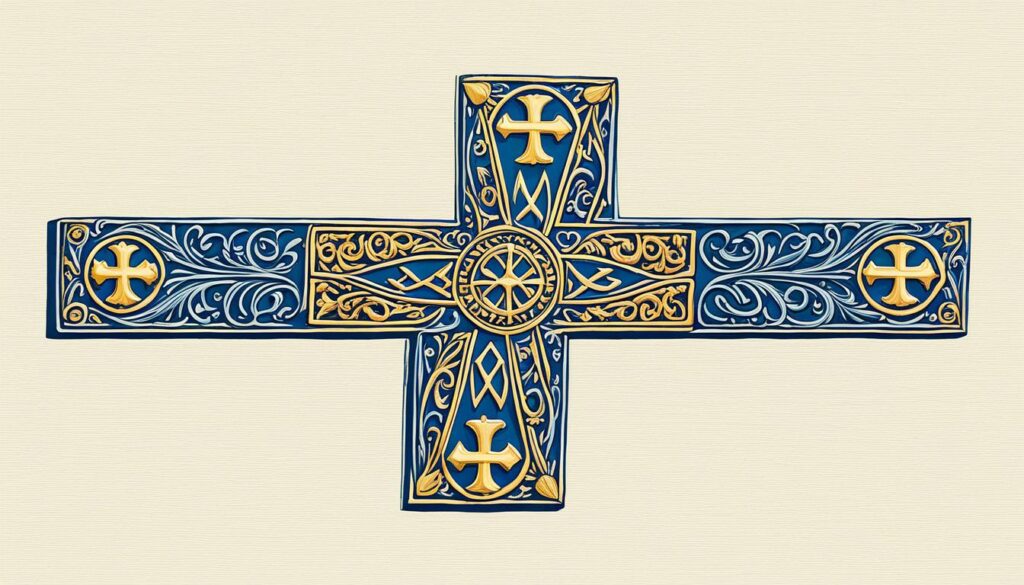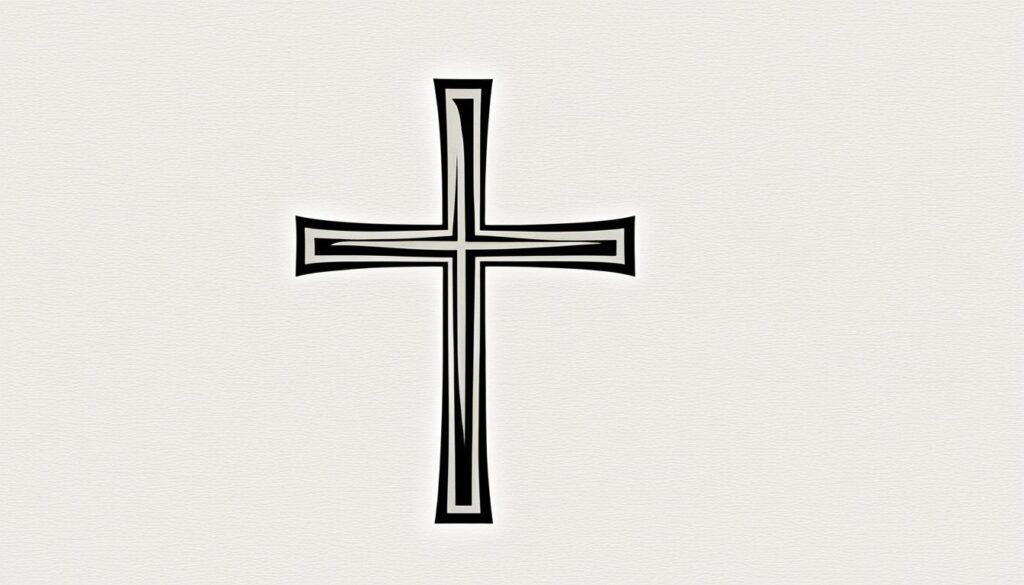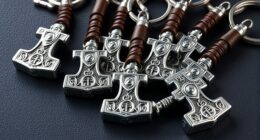Ever wondered about the deep **symbolism** behind Catholic crosses? These sacred symbols are more than just decorations—they’re powerful visual reminders of Catholic beliefs and values. Catholic crosses come in many designs, each carrying its own unique significance. Discover the **fascinating world** of Catholic crosses, uncover their hidden meanings, and learn why they’re spiritually important to believers.
Key Takeaways:
- Catholic crosses carry deep religious symbolism and serve as reminders of the core beliefs of the faith
- There are various types of Catholic crosses, each with its own unique design and meaning
- The Latin Cross, Celtic Cross, Papal Cross, St. Benedict Medal Cross, San Damiano Cross, Byzantine Cross, and Tau Cross are among the most common types
- These crosses symbolize aspects of Jesus’ sacrifice, redemption, love, and discipleship
- Catholic wall crucifixes, adorned with the image of Jesus on the cross, are objects of devotion and symbols of hope
The Latin Cross
The Latin Cross, also known as the Christian Cross, is the most commonly seen symbol in Catholic churches and worn as jewelry. It is a simple design with the horizontal beam positioned towards the top of the vertical beam. The Latin Cross is believed to be the type of cross used to crucify Jesus and has come to represent the core symbol of Christianity.
The Latin Cross, also referred to as the Christian Cross, holds significant religious meaning for Catholics. Representing the crucifixion of Jesus Christ, the Latin Cross is a powerful symbol of faith and redemption. Its simple yet profound design has become synonymous with Christianity and can be seen adorning churches and worn as a popular form of jewelry.
“The Latin Cross stands as a powerful reminder of the ultimate sacrifice made by Jesus for the salvation of humanity. It is a symbol of love, hope, and eternal life.”
Throughout history, the Latin Cross has held a central place in Catholic religious practices. It is prominently featured in church altars and stained glass windows, serving as a visual representation of Jesus’ sacrifice. The Latin Cross serves as a constant reminder of the love and selflessness demonstrated by Jesus, inspiring believers to live a life in accordance with His teachings.
In addition to its spiritual significance, the Latin Cross has also become an iconic and recognizable symbol across various cultures and communities. Its universal appeal transcends religious boundaries, making it a cultural and historical emblem of Christianity.
Key Features of the Latin Cross
The Latin Cross is characterized by its simple and elegant design. It consists of a vertical beam intersected by a shorter horizontal beam positioned towards the top. The vertical beam represents the upright posture of Jesus during His crucifixion, while the shorter horizontal beam symbolizes His outstretched arms.
The Symbolism of the Latin Cross
The Latin Cross carries deep symbolism within the Catholic faith. It represents the redemptive sacrifice of Jesus and the promise of eternal life for believers through His resurrection. The vertical beam signifies the connection between Heaven and Earth, while the horizontal beam represents the unification of humanity with God’s love.
Moreover, the Latin Cross is a constant reminder of the core teachings of Christianity, such as love, forgiveness, and the call to follow Christ. It serves as a visual representation of the ultimate act of selflessness and serves as an inspiration for believers to live a life of compassion and service.
The Latin Cross in Catholic Worship
Within Catholic worship, the Latin Cross holds a significant place. It is often displayed prominently in churches as a focal point of devotion. Catholics often carry or wear small Latin Cross pendants or crucifixes as a personal symbol of their faith. Many Catholic homes also feature a crucifix, providing a constant reminder of Jesus’ sacrifice and the importance of living a life rooted in Christian values.
| Symbol | Meaning |
|---|---|
| Latin Cross | A symbol of Jesus’ crucifixion and the core symbol of Christianity |
The Celtic Cross
The Celtic Cross is a highly recognizable symbol that originated in Ireland. It features a Latin Cross with a circle at the intersection of the beams, creating a unique and distinct design. Legend has it that St. Patrick introduced this cross to the pagans as a way to associate the Christian symbol with their own Sun worship.
The Celtic Cross holds significant meaning and is deeply intertwined with Irish culture. It serves as a powerful representation of the fusion of Christianity and the ancient Celtic traditions. The addition of the circle to the cross is believed to symbolize the harmony between the divine and earthly realms.
“The Celtic Cross is a testament to the rich cultural tapestry of Ireland. It beautifully captures the essence of the country’s history, spirituality, and artistic expression.”
Over the years, the Celtic Cross has become an iconic symbol associated with Irish heritage. It is commonly seen in religious art, jewelry, and gravestones, serving as a visual reminder of Ireland’s Christian roots and the enduring influence of its ancient culture.
Today, the Celtic Cross continues to gain popularity worldwide, not just among those of Irish descent but among people who appreciate its intricate design and spiritual significance. It has become a cherished symbol, representing faith, unity, and the interconnectedness of all things.

The Papal Cross/Bent Log Cross
The Papal Cross, also known as the Bent Log Cross, is a powerful symbol deeply rooted in Catholic tradition. This unique cross design features a downward-bent horizontal beam, resembling a bent log, which holds profound religious significance.
The symbolism of the Papal Cross is closely linked to the concept of sin and redemption. It represents the weight of all sins that Jesus bore on the cross, serving as a reminder of His sacrifice for humanity’s salvation. The bent log represents the burden of sins, bending under their weight, while also signifying the humility of Christ during His crucifixion.
Commissioned by Pope Paul VI, the Papal Cross has been used by every successive pope as a visual reminder of their role in carrying on the teachings and mission of Jesus Christ. It serves as a symbol of the papacy and the spiritual authority held by the popes.
Symbol of Sins and Redemption
The Papal Cross’s distinct design intentionally portrays the gravity of sins and the magnitude of Christ’s sacrifice. By visually emphasizing the downward-bent beam, the cross highlights the immense burden of sins that Jesus willingly took upon Himself, out of divine love and mercy.
The bent log serves as a poignant reminder of the redemption and forgiveness offered through Christ’s sacrificial death. It urges believers to reflect on their own sins, seek repentance, and avail themselves of God’s grace and forgiveness.
Significance for Popes
The Papal Cross holds particular significance for the popes who have carried the weight of their office and responsibilities. By choosing to embrace the symbolism of the Bent Log Cross, each pope acknowledges the importance of humility, compassion, and spiritual leadership in their role as the Vicar of Christ.
This cross serves as a visual reminder of the popes’ dedication to following in the footsteps of Jesus, guiding the Catholic Church, and fostering unity and faith among its followers.
Throughout history, the Papal Cross has become a recognized symbol of the popes and their contribution to the Church’s ongoing mission. It represents the spiritual authority and leadership embodied by each pope, as they navigate the challenges of their time and strive to uphold the teachings of Christ.
Comparison of Papal Cross and Bent Log Cross
| Papal Cross | Bent Log Cross |
|---|---|
| Symbolizes the weight of sins | Symbolizes the burden of sins, bending under their weight |
| Commissioned by Pope Paul VI | Symbol used by every successive pope |
| Represents the papacy and spiritual authority | Emphasizes humility and spiritual leadership |
In conclusion, the Papal Cross, or Bent Log Cross, holds deep symbolic meaning within the Catholic faith. Its unique design and representation of sins and redemption make it a powerful visual reminder of Christ’s sacrifice and the role of the popes in carrying on His mission. This cross serves as a tangible expression of faith, inspiring believers to reflect on their sins, seek reconciliation, and embrace the transformative power of God’s love and forgiveness.

The St. Benedict Medal Cross
The St. Benedict Medal Cross is a unique and powerful symbol that combines the St. Benedict Medal with the traditional image of Christ on the cross. This cross serves as a tangible reminder of spiritual protection and the presence of Christ in the lives of believers.
The St. Benedict Medal, featured prominently behind Christ’s head on the cross, is recognized for its ability to ward off evil and provide spiritual protection. The medal itself is adorned with a combination of symbols, including the image of St. Benedict, a cross, and Latin inscriptions, all of which contribute to its potent spiritual significance.
By incorporating the St. Benedict Medal into the design of the cross, the St. Benedict Medal Cross creates a profound synergy of symbols. This combination serves as a powerful source of spiritual strength and protection for those who wear or display it.
Believers often use the St. Benedict Medal Cross as a tangible expression of faith and a means of invoking spiritual protection. They draw comfort and reassurance from the presence of Christ on the cross, symbolizing His sacrifice and constant watchfulness over their lives.
Displaying the St. Benedict Medal Cross in homes, offices, or places of worship is a common practice among Catholic faithful who seek spiritual fortitude and protection. The power and significance of this cross lie not only in its design but also in the faith and devotion of the individuals who embrace its symbolism.
Benefits of the St. Benedict Medal Cross
The St. Benedict Medal Cross offers believers several key benefits:
- Spiritual Protection: The St. Benedict Medal Cross is renowned for its ability to provide spiritual protection against evil forces and negative influences.
- Symbolism: The combination of symbols in this cross represents various aspects of faith, including the presence of Christ, the intercession of St. Benedict, and the power of the cross itself.
- Constant Reminder: By wearing or displaying the St. Benedict Medal Cross, individuals are continually reminded of their faith and the need for spiritual protection in their lives.
Example of a St. Benedict Medal Cross
Below is an example of what a St. Benedict Medal Cross may look like:
| Image | Description |
|---|---|
 |
A St. Benedict Medal Cross featuring a silver-tone cross pendant with the St. Benedict Medal incorporated behind Christ’s head. The cross is worn on a chain necklace. |
“The St. Benedict Medal Cross provides believers with spiritual protection and a constant reminder of Christ’s presence in their lives.”
The San Damiano Cross
The San Damiano Cross holds great significance for followers of St. Francis of Assisi and is particularly popular among Franciscans. This cross is characterized by its ornate design, featuring intricate details and depictions of significant figures at the foot of the cross.
The San Damiano Cross bears depictions of Mary, John the Evangelist, Mary Magdalene, and others present during Jesus’ crucifixion. These depictions serve as visual reminders of the powerful presence and witness of these individuals during that sacred moment.
The San Damiano Cross is not only revered for its artistic beauty but also for its connection to St. Francis’ vision to repair and rebuild the Church. This cross serves as a symbol of St. Francis’ dedication to the Franciscan order, his deep commitment to prayer and contemplation, and his mission to bring spiritual renewal.
San Damiano Cross Example:

A Visual Representation of St. Francis’ Vision
The San Damiano Cross, with its detailed craftsmanship and symbolic depictions, embodies St. Francis’ vision to repair not only the physical structure of the Church but also the spiritual vitality and integrity of the Christian faith. It stands as a testament to St. Francis’ desire to follow in Christ’s footsteps and live a life of poverty, simplicity, and devotion.
The Byzantine Cross
The Byzantine Cross is a unique and significant symbol within the Eastern Orthodox Church. Its design stands out due to the inclusion of three horizontal bars, each carrying its own symbolism. The longer upper bar represents the placement of Christ’s hands during crucifixion, while the two shorter bars below underline the direction towards Heaven and Hell.
In Orthodox symbolism, the placement of the three horizontal bars on the Byzantine Cross holds deep meaning. It serves as a constant reminder of the sacrifice of Jesus and the ultimate fate of mankind, emphasizing the crucial role of salvation and humanity’s eternal destiny.
The Byzantine Cross is steeped in history, tracing back to the Byzantine Empire, which heavily influenced religious art and iconography during its reign. Today, this cross design remains a powerful representation of the Orthodox faith.
Believers turn to the Byzantine Cross as a visual symbol of hope, faith, and redemption. Its iconic form serves as a spiritual reminder of Jesus’ sacrifice and the promise of eternal life for those who follow Him. It is a potent emblem of the Orthodox Church’s teachings and a source of strength and inspiration for its followers.
Orthodox Symbolism
Orthodox Christianity has a robust tradition of symbolism, and the Byzantine Cross is an integral part of this rich symbolic language. Alongside the intricate representation of the three horizontal bars, the Byzantine Cross often incorporates other symbolic elements, such as decorative patterns or religious icons.
In Eastern Orthodox worship, the Byzantine Cross plays a prominent role. It is commonly displayed in churches, adorning the walls and altars as a central visual focal point to invoke prayer and devotion.
The Byzantine Cross is not only a representation of Jesus’ crucifixion but also a manifestation of the Orthodox faith, encapsulating its core teachings and beliefs. Its unique design and symbolism continue to resonate with Orthodox Christians worldwide, serving as a powerful testament to their devotion and commitment to their religious heritage.

Byzantine Cross Symbolism: A Visual Representation
| Symbolism | Description |
|---|---|
| The three horizontal bars | Represents the placement of Christ’s hands during crucifixion and symbolizes the ultimate fate of mankind. |
| Slanted beam at the bottom | Symbolizes the direction towards Heaven and Hell. |
| Decorative patterns and religious icons | Often incorporated into the cross design, further enhancing its symbolism and significance within Orthodox Christianity. |
The Tau Cross
The Tau Cross, also known as the Greek Cross, takes its name from the Greek letter “tau” (Τ), which is in the shape of a cross without the upper part of the vertical beam. This simple yet powerful symbol holds deep biblical symbolism and is associated with holiness.
The Tau Cross has been significant in Christianity for centuries and serves as a reminder of the call to live a holy life. It has gained popularity due to its connection with St. Francis of Assisi, who embraced this cross as a symbol of his devotion and commitment to imitating Christ’s example.
St. Francis of Assisi, known for his humility and love for all God’s creations, found inspiration in the Tau Cross. He saw in this symbol a representation of the embrace of the whole Gospel and the commandment to love God and one’s neighbor.

Greek Symbolism
In Greek symbolism, the Tau Cross represents perfection and completion. It signifies the union of the earthly and divine realms, as the horizontal line represents the material world, while the vertical line symbolizes the spiritual realm. The Tau Cross embodies the idea of spiritual transformation and the pursuit of divine wisdom.
A Symbol of Holiness
The Tau Cross is regarded as a symbol of holiness and spiritual integrity. It serves as a visual reminder to lead a virtuous life and strive for the pursuit of God’s will. By embracing the teachings of Christ and living in accordance with His commandments, believers can find spiritual fulfillment and experience the true meaning of holiness.
The Tau Cross holds deep meaning not only in the Catholic faith but also in other branches of Christianity. Its simplicity and powerful symbolism make it a cherished symbol for those seeking to live a life dedicated to Christ’s teachings and exemplify holiness.
| Tau Cross | Greek Symbolism | A Symbol of Holiness |
|---|---|---|
| The Tau Cross, also known as the Greek Cross, derives its name from the Greek letter “tau” (Τ). | In Greek symbolism, the Tau Cross represents perfection and completion. | The Tau Cross is regarded as a symbol of holiness and spiritual integrity. |
| This simple yet powerful symbol holds deep biblical symbolism and serves as a reminder to live a holy life. | The Tau Cross embodies the idea of spiritual transformation and the pursuit of divine wisdom. | By embracing the teachings of Christ, believers can find spiritual fulfillment and experience holiness. |
| St. Francis of Assisi embraced the Tau Cross as a symbol of his devotion and commitment to imitating Christ. | The Tau Cross signifies the union of the earthly and divine realms. | Living in accordance with Christ’s commandments leads to the true meaning of holiness. |
Conclusion
Catholic crosses hold deep religious symbolism and serve as visual reminders of the core beliefs and values of Catholicism. Each cross design carries its own unique meaning, reflecting aspects of Jesus’ sacrifice, redemption, love, and discipleship. The symbolism of crosses goes beyond their physical form; they represent a spiritual significance that resonates with believers.
Catholic wall crucifixes, adorned with the image of Jesus on the cross, become objects of devotion, prayer, and comfort for believers. They serve as statements of faith and symbols of hope, offering solace in times of sorrow and reminding believers of the eternal life promised through Christ’s resurrection. When displayed in homes or places of worship, Catholic wall crucifixes create an atmosphere of reverence and serve as focal points for prayer and meditation.
The spiritual significance of crosses in the Catholic faith goes beyond their decorative purpose. They serve as reminders of Christ’s sacrifice and the redemption He offers. Catholic wall crucifixes symbolize the depth of God’s love and the victory over sin and death. As believers gaze upon the image of Jesus on the cross, they find strength, inspiration, and a reaffirmation of their faith. With their rich symbolism and spiritual meaning, Catholic crosses and wall crucifixes continue to hold a special place in the hearts of believers and serve as tangible expressions of their devotion.
FAQ
What is the significance of Catholic crosses?
What is a Latin Cross?
What is a Celtic Cross?
What is a Papal Cross/Bent Log Cross?
What is a St. Benedict Medal Cross?
What is a San Damiano Cross?
What is a Byzantine Cross?
What is a Tau Cross?
How Does the Catholic Cross Symbol Relate to Death in Wedding Dreams?
In wedding dream symbolism meanings, the Catholic cross symbol represents both death and new beginnings in marriage. It signifies the end of an individual’s single life and the start of a new union with their partner. The cross’s presence in wedding dreams can reflect the transition from one phase of life to another.










